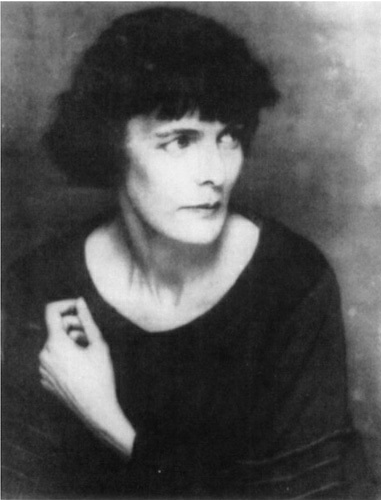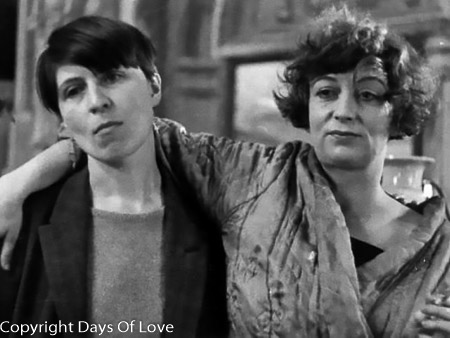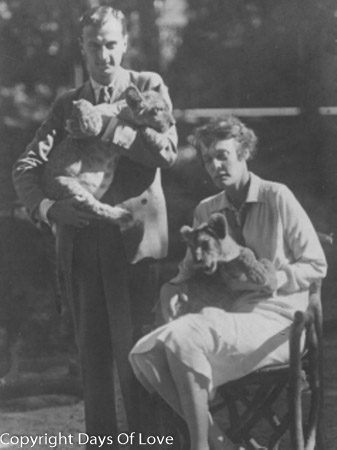

Partner Bryher
Queer Places:
Bryn Mawr College (Seven Sisters), 101 N Merion Ave, Bryn Mawr, PA 19010
Friends' Central School, 1101 City Ave, Wynnewood, PA 19096, Stati Uniti
44 Mecklenburgh Square, London WC1N 2AJ, Regno Unito
Riant Chateau, Territet, 1820 Montreux, Svizzera
Nisky Hill Cemetery, 254 E Church St, Bethlehem, PA 18018, Stati Uniti
 Hilda
"H.D." Doolittle (September 10, 1886 – September 27, 1961) was an American
poet, novelist, and memoirist, associated with the early 20th century
avant-garde Imagist group of poets, including
Ezra Pound and
Richard Aldington.
She published under the pen name H.D. Bryher nursed H.D. back to health after
her disastrous marriage and pregnancy. Their many years together are
chronicled in Bryher's autobiography, The Heart of Artemis.
Hilda
"H.D." Doolittle (September 10, 1886 – September 27, 1961) was an American
poet, novelist, and memoirist, associated with the early 20th century
avant-garde Imagist group of poets, including
Ezra Pound and
Richard Aldington.
She published under the pen name H.D. Bryher nursed H.D. back to health after
her disastrous marriage and pregnancy. Their many years together are
chronicled in Bryher's autobiography, The Heart of Artemis.
American and English novelists such as Gertrude Stein and Bryher, poets suche as Hilda Doolittle, and publishers such as Sylvia Beach all developed different and unique ways of expressing themselves both as lesbians and as exiles in the absence of lesbbian literary and artistic traditions in the decades before the Second World War.
Historical homosocial and homosexual communities of expatriate American and English women lived in Paris on the Left Bank of the Seine during the opening decades of the twentieth century. The place and time has captured the imaginations of feminist and queer historians, literary critics, art historians, and cultural theorists. These histories of women and their cultural productions are attractive because they demand a rethinking and rewriting of the canonical histories of masculine modernism. The geographical and spiritual locus for these groups were the literary and artistic salons of Natalie Barney and Gertrude Stein, as well as the bookshops and publishing houses owned by Sylvia Beach and Adrienne Monnier. Congregating at these cultural landmarks, Janet Flanner, Colette, Renée Vivien, Djuna Barnes, Hilda Doolittle, Claude Cahun, Marcel Moore (Suzanne Malherbe), Anaïs Nin, and many others invented new ways of living and representing themselves and each other. Martha Vicinus writes: The most striking aspect of the lesbian coteries of the 1910s and 1920s was their self-conscious effort to create a new sexual language for themselves that included not only words but also gestures, costume and behavior. Lillian Faderman notes that these Parisian communities “functioned as a support group for lesbians to permit them to create a self-image which literature and society denied them.”


Hilda was born in Bethlehem, Pennsylvania in 1886. The modernist poet Marianne Moore was among her classmates during their freshman year at Bryn Mawr College (Moore's first book, Poems, was published without her permission in 1921 by H.D. and H.D.'s partner, the British novelist Bryher). She moved to London in 1911, where she played a central role within the then emerging Imagist movement. Her poetry was published by Dora Marsden. A charismatic figure, she was championed by the modernist poet Ezra Pound, who was instrumental in building and furthering her career. She and Pound shared another interest, Frances Josepha Gregg. A romantic triangle began in 1910 and ended shortly thereafter, with Hilda, Gregg and Gregg's mother, leaving for Europe where Hilda began a serious career as a writer. Her relationship with Frances cooled and Hilda went on to meet and possibly have an affair with Brigit Patmore. Brigit in turn introduced Hilda to Richard Aldington, a freelance writer and poet. They were married in 1912 but divorced six years later after accusations of adultery and the still-birth of their only child in 1915. On the rebound, she had a brief relationship with Cecil Gray, a musicologist, with whom she had a child, Frances Perdita.
From 1916–17, H.D. acted as the literary editor of the Egoist journal, while her poetry appeared in the English Review and the Transatlantic Review. During the First World War, H.D. suffered the death of her brother and the breakup of her marriage to the poet Richard Aldington,[1] and these events weighed heavily on her later poetry. Imagist authority Glenn Hughes wrote that 'her loneliness cries out from her poems'.[2] She had a deep interest in Ancient Greek literature, and her poetry often borrowed from Greek mythology and classical poets. Her work is noted for its incorporation of natural scenes and objects, which are often used to emote a particular feeling or mood.
The editors of Poetry, Harriet Monroe and Alice Corbin Henderson included in their 1917 selection for The New Poetry: An Anthology poems by H.D.. According to Adrienne Munich and Melissa Bradshaw, authors of Amy Lowell, American Modern, what connects these poets is their appartenance to the queer sisterhood.
She befriended Sigmund Freud during the 1930s, and became his patient in order to understand and express her bisexuality, her residual war trauma, her writing, and her spiritual experiences.[3] H.D. married once, and undertook a number of relationships with both men and women. She was unapologetic about her sexuality, and thus became an icon for both the LGBT rights and feminist movements when her poems, plays, letters and essays were rediscovered during the 1970s and 1980s.
Close to the end of the war, H.D. met the wealthy English novelist Bryher (Annie Winifred Ellerman). They lived together until 1946, and although both took numerous other partners, Bryher remained her lover for the rest of H.D.'s life. In 1919, H.D. came close to death when she gave birth to her daughter Frances Perdita Aldington—although the father was not Aldington, but Gray—while suffering from war influenza.[25] During this time, her father, who had never recovered from Gilbert's death, died. In 1919, H.D. wrote one of her few known statements on poetics,[26] Notes on Thought and Vision, which was unpublished until 1982.[27] In this, she speaks of poets (herself included) as belonging to a kind of elite group of visionaries with the power to 'turn the whole tide of human thought'.
H.D. and Aldington attempted to salvage their relationship during this time, but he was suffering from the effects of his participation in the war, possibly post-traumatic stress disorder, and they became estranged, living completely separate lives, but not divorcing until 1938. They remained friends, however, for the rest of their lives. From 1920, her relationship with Bryher became closer, and the pair travelled in Egypt, Greece and the United States before eventually settling in Switzerland. Bryher entered a marriage of convenience in 1921 with Robert McAlmon, which allowed him to fund his publishing ventures in Paris by utilising some of her personal wealth for his Contact Press.[28] Both Bryher and H.D. slept with McAlmon during this time. Bryher and McAlmon divorced in 1927.[29]
In the early 1920s, H.D. started to write three projected cycles of novels.[30] The first of these, Magna Graeca, consists of Palimpsest (1921) and Hedylus (1928). The Magna Graeca novels use their classical settings to explore the poetic vocation, particularly as it applies to women in a patriarchal literary culture. The Madrigal cycle consists of HERmione, Bid Me to Live, Paint It Today and Asphodel, and is largely autobiographical, dealing with the development of the female artist and the conflict between heterosexual and lesbian desire. Kora and Ka and The Usual Star, two novellas from the Borderline cycle, were published in 1933. In this period, she also wrote Pilate's Wife, Mira-Mare, and Nights.
During this period her mother had died, and Bryher had divorced her husband, only to marry H.D.'s new male lover, Kenneth Macpherson. H.D., Bryher, and Macpherson lived together and traveled through Europe as what the poet and critic Barbara Guest termed in her biography of H.D. as a 'menagerie of three.'[31] Bryher and Macpherson adopted H.D.'s daughter, Perdita.[4] In 1928, H.D. became pregnant but chose to abort the pregnancy in November. Bryher and Macpherson set up the magazine Close Up (to which H.D. regularly contributed) as a medium for intellectual discussion of cinema. In 1927, the small independent film cinema group POOL or Pool Group was established (largely funded with Bryher's inheritance) and was managed by all three.[32] Only one POOL film survives in its entirety, Borderline (1930), which featured H.D. and Paul Robeson in the lead roles. In common with the Borderline novellas, the film explores extreme psychic states and their relationship to surface reality. As well as acting in this film, H.D. wrote an explanatory pamphlet to accompany it, a piece later published in Close Up.[33]
In 1933, H.D. traveled to Vienna to undergo analysis with Sigmund Freud.[34] She had an interest in Freud's theories as far back as 1909, when she read some of his works in the original German.[35] H.D. was referred by Bryher's psychoanalyst due to her apparent paranoia about the rise of Adolf Hitler which indicated another world war, an idea that H.D. found intolerable. The Great War (World War I) had left her feeling shattered. She had lost her brother in action, while her husband suffered effects of combat experiences, and she believed that the onslaught of the war indirectly caused the death of her child with Aldington: she believed it was her shock at hearing the news about the RMS Lusitania that directly caused her child to be stillborn.[36] Writing on the Wall, her memoir about this psychoanalysis, was written concurrently with Trilogy and published in 1944; in 1956 it was republished with Advent, a journal of the analysis, under the title Tribute to Freud.[37]
In 1934 Silvia Dobson discovered Hilda "H.D." Doolittle's work and wrote her a letter of admiration. Doolittle replied, inviting Dobson to come meet her in her London home. After meeting, they began a brief love affair that was, in Dobson’s words, much more important to her than it was to H.D. Though the affair quickly ended, Dobson and H.D. remained friends, visiting and corresponding frequently until H.D.’s death in 1961. Dobson kept every letter.
H.D. and Bryher spent the duration of World War II in London. During this time, H.D. wrote The Gift, a memoir of her childhood and family life in Bethlehem, Pennsylvania, which reflects on people and events in her background that helped shape her as a writer.[38] The Gift was eventually published in 1960 and 1982.[39] She also wrote Trilogy, published as The Walls do not Fall (1944), Tribute to the Angels (1945) and The Flowering of the Rod (1946). The opening lines of The Walls do not Fall clearly and immediately signal H.D.'s break with her earlier work:
An incident here and there,
and rails gone (for guns)
from your (and my) old town square.[40]
After the war, H.D. and Bryher no longer lived together, but remained in contact. H.D. moved to Switzerland where, in the spring of 1946, she suffered a severe mental breakdown, which resulted in her staying in a clinic until the autumn of that year. Apart from a number of trips to the States, H.D. spent the rest of her life in Switzerland. In the late 1950s, she underwent more treatment, this time with the psychoanalyst Erich Heydt.[41] At Heydt's prompting, she wrote End to Torment, a memoir of her relationship with Pound, who allowed the poems of Hilda's Book to be included when the book was published. Doolittle was one of the leading figures in the bohemian culture of London in the early decades of the century. Her later poetry explores traditional epic themes, such as violence and war, from a feminist perspective. H.D. was the first woman to be granted the American Academy of Arts and Letters medal.[8][8]
During the 1950s, H.D. wrote a considerable amount of poetry, most notably Helen in Egypt (written between 1952–54), an examination from a feminist point of view of a male-centred epic poetry. H.D. used Euripides's play Helen as a starting point for a reinterpretation of the basis of the Trojan War and, by extension, of war itself.[42] This work has been seen by some critics, including Jeffrey Twitchell-Waas, as H.D.'s response to Pound's Cantos, a work she greatly admired. Other poems from this period include Sagesse, Winter Love and Hermetic Definition. These three were published posthumously with the collective title Hermetic Definition (1972). The poem Hermetic Definition takes as its starting points her love for a man 30 years her junior and the line 'so slow is the rose to open' from Pound's Canto 106. Sagesse, written in bed after H.D. had broken her hip in a fall, serves as a kind of coda to Trilogy. being partly written in the voice of a young female Blitz survivor who finds herself living in fear of the atom bomb. Winter Love was written together with End to Torment and uses as narrator the Homeric figure of Penelope to restate the material of the memoir in poetic form. At one time, H.D. considered appending this poem as a coda to Helen in Egypt.[43]
H.D. visited the United States in 1960 to collect an American Academy of Arts and Letters medal.[44] Returning to Switzerland, she suffered a stroke in July 1961 and died a couple of months later in the Klinik Hirslanden in Zürich.[45] Her ashes were returned to Bethlehem, and were buried in the family plot in the Nisky Hill Cemetery on October 28, 1961.
My published books: